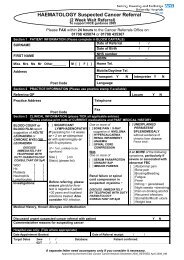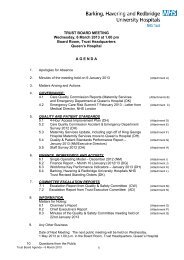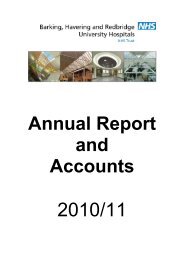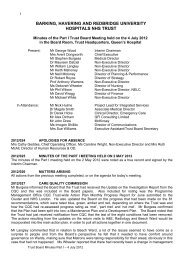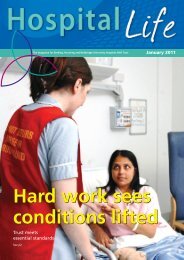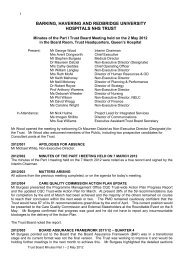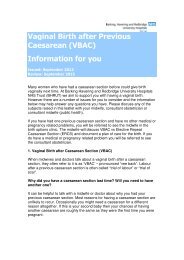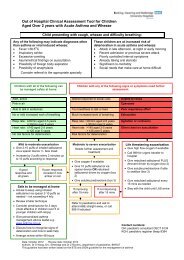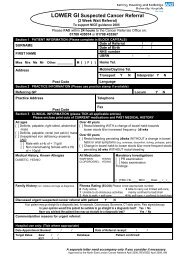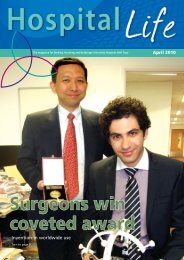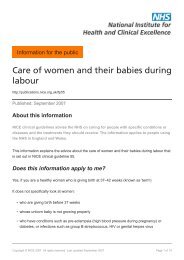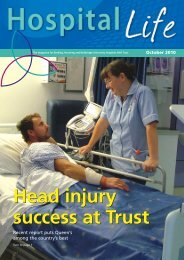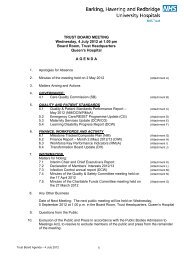BHRUT annual report 2009 - Barking Havering and Redbridge ...
BHRUT annual report 2009 - Barking Havering and Redbridge ...
BHRUT annual report 2009 - Barking Havering and Redbridge ...
Create successful ePaper yourself
Turn your PDF publications into a flip-book with our unique Google optimized e-Paper software.
Annual Report & Accounts <strong>2009</strong>-2010<br />
47<br />
An element of the <strong>annual</strong> unitary payment increase<br />
due to cumulative indexation is allocated to the<br />
finance lease. In accordance with IAS 17, this amount<br />
is not included in the minimum lease payments, but is<br />
instead expensed as incurred.<br />
Lifecycle replacement<br />
The Trust pays a contribution to the lifecycle<br />
replacement costs of building assets requiring<br />
replacement through the <strong>annual</strong> unitary payment. In<br />
return, the PFI operator maintains a contractual<br />
obligation to maintain the facility to an agreed<br />
st<strong>and</strong>ard, but is under no direct obligation to spend<br />
the lifecycle funds at pre-determined intervals. The<br />
Trusts receives no financial benefit for any lifecycle<br />
savings derived during the duration of the PFI<br />
agreement. Conversely, the Trust does not bear the<br />
the risk of additional lifecycle costs should the facility<br />
require additional work. As a result, these lifecycle<br />
replacement charges are recognised as an expense in<br />
the period they arise.<br />
The Managed Equipment Service agreement contained<br />
within the PFI agreement includes expected lifecycle<br />
replacement of medical equipment at specified times<br />
at the expected end of useful life of the assets. Since<br />
the Trust does not physically possess these future<br />
assets at the same time, assets <strong>and</strong> liabilities are only<br />
recognised to the extent that they relate to the<br />
equipment available for use. In addition, future<br />
replacement of these assets can be varied by<br />
agreement. The lifecycle replacement of these assets<br />
effectively results in a series of finance leases in<br />
accordance with the individual replacement cycles.<br />
Assets contributed by the Trust to the operator<br />
for use in the scheme<br />
Assets contributed for use in the scheme continue to<br />
be recognised as items of property, plant <strong>and</strong><br />
equipment in the Trust’s Statement of Financial<br />
Position.<br />
Other assets contributed by the Trust to the<br />
operator<br />
Assets contributed (e.g. cash payments, surplus<br />
property) by the trust to the operator before the asset<br />
is brought into use, which are intended to defray the<br />
operator’s capital costs, are recognised initially as<br />
prepayments during the construction phase of the<br />
contract. Subsequently, when the asset is made<br />
available to the Trust, the prepayment is treated as an<br />
initial payment towards the finance lease liability <strong>and</strong><br />
is set against the carrying value of the liability.<br />
1.17 Inventories<br />
Inventories are valued at the lower of cost <strong>and</strong> net<br />
realisable value using the first-in first-out cost formula.<br />
This is considered to be a reasonable approximation to<br />
fair value due to the high turnover of stocks.<br />
1.18 Cash <strong>and</strong> cash equivalents<br />
Cash is cash in h<strong>and</strong> <strong>and</strong> deposits with any financial<br />
institution repayable without penalty on notice of not<br />
more than 24 hours. Cash equivalents are<br />
investments that mature in 3 months or less from the<br />
date of acquisition <strong>and</strong> that are readily convertible to<br />
known amounts of cash with insignificant risk of<br />
change in value.<br />
In the Statement of Cash Flows, cash <strong>and</strong> cash<br />
equivalents are shown net of bank overdrafts that are<br />
repayable on dem<strong>and</strong> <strong>and</strong> that form an integral part<br />
of the Trust’s cash management.<br />
1.19 Provisions<br />
Provisions are recognised when the Trust has a present<br />
legal or constructive obligation as a result of a past<br />
event, it is probable that the Trust will be required to<br />
settle the obligation, <strong>and</strong> a reliable estimate can be<br />
made of the amount of the obligation. The amount<br />
recognised as a provision is the best estimate of the<br />
expenditure required to settle the obligation at the<br />
end of the <strong>report</strong>ing period, taking into account the<br />
risks <strong>and</strong> uncertainties. Where a provision is measured<br />
using the cash flows estimated to settle the obligation,<br />
its carrying amount is the present value of those cash<br />
flows using HM Treasury’s discount rate of 2.2% in<br />
real terms.<br />
When some or all of the economic benefits required<br />
to settle a provision are expected to be recovered from<br />
a third party, the receivable is recognised as an asset if<br />
it is virtually certain that reimbursements will be<br />
Annual Accounts



![[4] Biopsy Leaflet.pub - Barking, Havering and Redbridge University ...](https://img.yumpu.com/51285530/1/190x134/4-biopsy-leafletpub-barking-havering-and-redbridge-university-.jpg?quality=85)

